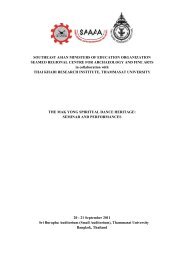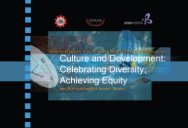on Culture & Development - Seameo-SPAFA
on Culture & Development - Seameo-SPAFA
on Culture & Development - Seameo-SPAFA
- No tags were found...
Create successful ePaper yourself
Turn your PDF publications into a flip-book with our unique Google optimized e-Paper software.
56Introducti<strong>on</strong>Following <strong>on</strong> from the previous day’sexplorati<strong>on</strong> of meanings of culture,Day 2 begins by gatheringparticipants’ images of developmentas a way to generate discussi<strong>on</strong>around our different understandingsand impressi<strong>on</strong>s of what developmentis, could or should be. In a relativelyshort space of time, the wide range ofimages produced, manage to raise anumber of ideas, opini<strong>on</strong>s, issues andc<strong>on</strong>cerns. A recurring theme am<strong>on</strong>gthose collected during the course ofthese workshops was thatdevelopment is failing to live up topeople’s expectati<strong>on</strong>s and thatimportant goals are not beingachieved. To begin to understand whythis is the case, the follow-<strong>on</strong>activities <strong>on</strong> this day start to explorewhat is happening in the planningstages of projects, and morespecifically to c<strong>on</strong>sider the kind oftools we use in the planning processand how we use them.An initial brainstorm activityhighlights just how many tools thereare, especially within workshopgroups c<strong>on</strong>sisting of academics andresearchers, planners, administratorsand implementers, and c<strong>on</strong>sideringthe range of disciplines covered.Encouraging participants to name andprovide a brief descripti<strong>on</strong> of a tool,including what can be achievedthrough its use, alerts the group tothe fact that <strong>on</strong>e tool may be knownunder different names; it also helps usto identify alternative tools to thosewe may be familiar with; it touches <strong>on</strong>how tools may complement eachother; and raises awareness of theneed to be creative and to maximizetheir potential. When talking aboutparticipatory processes, this latterpoint is extremely important as whatwe need are the kind of tools andpers<strong>on</strong>al approaches that are flexibleenough to allow us to explore,experience, and learn. Such tools willgive us a directi<strong>on</strong> in which to travelbut still leave us open to resp<strong>on</strong>d tothe people and c<strong>on</strong>text we areworking in.To emphasise the fact that it is not soimportant what tools we use but howwe use them, Activity 2.5 -Stakeholder Analysis, involves a morein-depth analysis of just <strong>on</strong>e tool. As apreliminary identificati<strong>on</strong> of whoshould be involved in the identificati<strong>on</strong>of a problem and planning of aparticular project, StakeholderAnalysis represents the first importantstep towards building the relati<strong>on</strong>shipsneeded for the success of participatory










